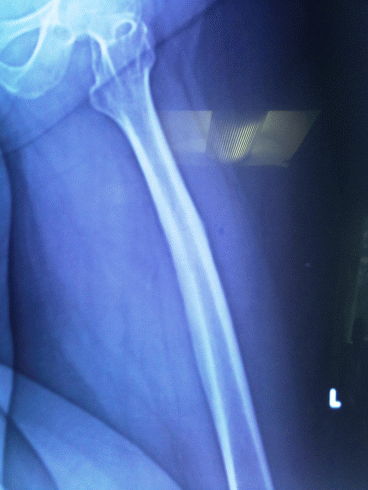ICEECE2012 Poster Presentations Calcium & Vitamin D metabolism (73 abstracts)
Two cases of alendronate induced atypical fracture of femur shaft
T. Varma , R. Panchani , A. Saini , S. Tripathi & N. Gupta
Sir Gangaram Hospital, New Delhi, India.
Studies show conflicting results regarding possible excess risk of atypical fractures associated with bisphosphonate (BSP) use. Since BSP reduces bone remodeling, they freeze the skeleton allowing accumulation of microcracks over time leading to atypical fractures. We present two cases of atypical fracture and discuss on monitoring therapy and drug holiday in chronic BSP users.
Methods: Over the period of last 8 months we diagnosed two cases of alendronate induced atypical fracture of femur shaft the details of which are given below. Case 1 A 48-year-old postmenopausal female presented with limp and right anterior thigh pain. X-ray revealed a focal beak of cortical thickening on lateral side of cortex which after 3 months resulted in to bicortical femoral shaft fracture. She was on BSP since last 10 years. Bone turnover markers were done. Stabilization of the fragile bone was done with intramedullary nailing. However, the femur cracked during surgery.
Case 2 A 52-year-old female patient presented with bilateral thigh pain and on evaluation showed cortical thickening and hairline fracture on both sides. She had a history of longterm use of alendronate since last 5 years. The fracture was stabilized on both the sides with intramedullary nailing. The right sided bone cracked during nailing. Urinary N telopeptide levels were done. And intraoperative bone biopsy was also taken.
Results: Both the patients had very low bone turnover markers and showed bone necrosis in bone biopsy. Tetracycline labeling was not done as was not available in our institute. Both the patients on follow up showed poor healing of fractures and were started on teripartide once daily.
Conclusion: Optimal protocols for dosage, duration of BSP therapy deserve consideration. Benefit of BSP use should be balanced against potential risk of atypical fractures. Painful pyramidal projection of cortical bone in subtrochanteric femoral shaft should be recognized as an impending fracture and treated expediously. Additional therapy after BSP discontinuation is needed to promote healing.

Figure 1 Showing transverse fracture on left femur diaphysis with lateral cortical thickening.
Declaration of interest: The authors declare that there is no conflict of interest that could be perceived as prejudicing the impartiality of the research project.
Funding: This research did not receive any specific grant from any funding agency in the public, commercial or not-for-profit sector.
 }
}



